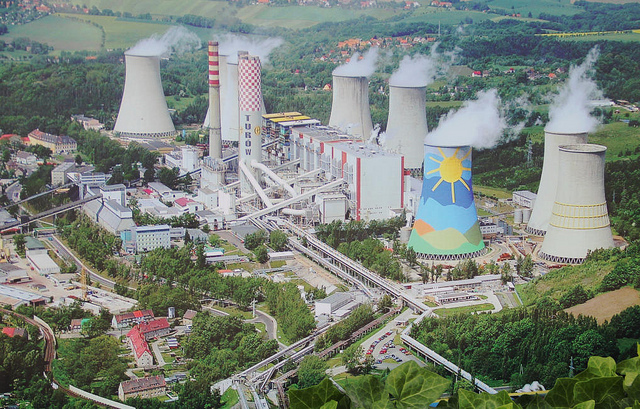 Fossil fuel divestment, which entails getting out of investments in stocks, bonds, or funds that back fossil fuel companies or initiatives, is an admirable goal, as it attempts to remove the profit from planet-wrecking businesses, but it’s not nearly as simple as it seems, and it could be a very costly endeavor – as much as $5 trillion.
Fossil fuel divestment, which entails getting out of investments in stocks, bonds, or funds that back fossil fuel companies or initiatives, is an admirable goal, as it attempts to remove the profit from planet-wrecking businesses, but it’s not nearly as simple as it seems, and it could be a very costly endeavor – as much as $5 trillion.
Joshua S. Hill, at our sister site CleanTechnica, has the story:
Divesting From Fossil Fuel Would Cost $5 Trillion
Investors face a tremendous challenge moving forward in an increasingly environmentally-conscious world, where environmental concerns, so-called ‘ethical’ investment strategies, and fears that fossil fuel assets could eventually become “stranded” by emission regulations are forcing gradual fossil fuel divestment.
However, according to new research from Bloomberg New Energy Finance, such movements are up against a $5 trillion fossil fuel challenge, making complete or even-partial fossil fuel divestment tricky.
Bloomberg New Energy Finance (BNEF) has released figures which show that oil, gas, and coal companies currently make up one of the world’s largest liquid asset classes, registering a combined stock market valuation of nearly $5 trillion.
“Fossil fuels are investor favourites for a reason,” said White Paper author Nathaniel Bullard. “Very few other investments offer the scale, liquidity, growth, and yield of these century-old businesses with economy-wide demand for their products.
Fossil fuel companies have simply stood the test of time, and the inherent stability of fossil fuel energy generation has made them literally invaluable the world over.
“Given their scale and performance, oil and gas companies are attractive to institutional investors,” Bullard added. “Coal firms, smaller and recently underperforming wider markets, are less of a focus for institutions.
Alongside this mammoth trillion-dollar entrenchment is the sheer distance renewable energy has to go to compete on a larger scale with fossil fuels. BNEF forecast that $5.5 trillion is needed and expected over the next 15 years to build out renewable energy sources as a competitive energy infrastructure, and even with this gigantic hurdle, Bloomberg points out that “pension funds or institution asset managers may not integrate clean energy into their portfolios” due simply to the risk-factor associated these days with renewable energies.
Renewable energy investment is by no means a struggling investment opportunity — one need only read back through our Green Economy-Investment category to see the proof of that. Millions and sometimes billions of dollars are invested each month into a variety of projects ranging from the small to the absurd. However, to challenge fossil fuel as the dominant energy investment choice, there’s a long hill to tread.
“The $5.5 trillion needed to build out clean energy through 2030 will offer many new opportunities for investors, but a major switch into that and out of fossil fuels would require a massive scale-up of new investment vehicles,” explained Bullard.
Beyond the simple challenge of meeting fossil fuel-level investment figures is the fact that the future of renewable energy investment is simply not as secure as we might like. Political uncertainty abounds throughout the world, none more blatantly than in Australia where the current climate of renewable energy investment is likely to take a dramatic turn if the current government has its way.
A new report published earlier this month by the Green Alliance also raises its own problems, stating that the aging Generation-Y is simply not likely to invest as thoroughly and confidently in renewable energy technologies as their predecessors.
While the numbers predict a gloomy future for those of us hoping renewable energy can usurp fossil fuel’s crown, let us hope that it only spurs us on towards bigger and better things, rather than putting a halt on things.
The White Paper is available for download here, and the press release with further numbers regarding both the fossil fuel and clean energy industries is available here.
[Originally published by Joshua S. Hill on CleanTechnica.]




I wonder how much global warming and the total destruction of California will cost? Bloomberg’s corporate masters probably won’t let them publish THAT figure.
I’m confused by this article. Is this supposed to discourage us from divesting? Or is it just reminding us (again) that real environmental reform is very hard? If we’re going to decry fossil fuel companies and their treatment of the environment, it’s just wrong for us to continue giving them our money. I’d be interested in a follow-up article that explains how we can invest smartly if we do decide to take the higher, “so-called ‘ethical'”, investment ground. We are not limited to investing in fossil fuels and renewables. Could we divest from fossil fuels and invest in another lucrative industry (i.e. tech)?
Another inspiring article for renewable energy!
Thank you so much for sharing post.